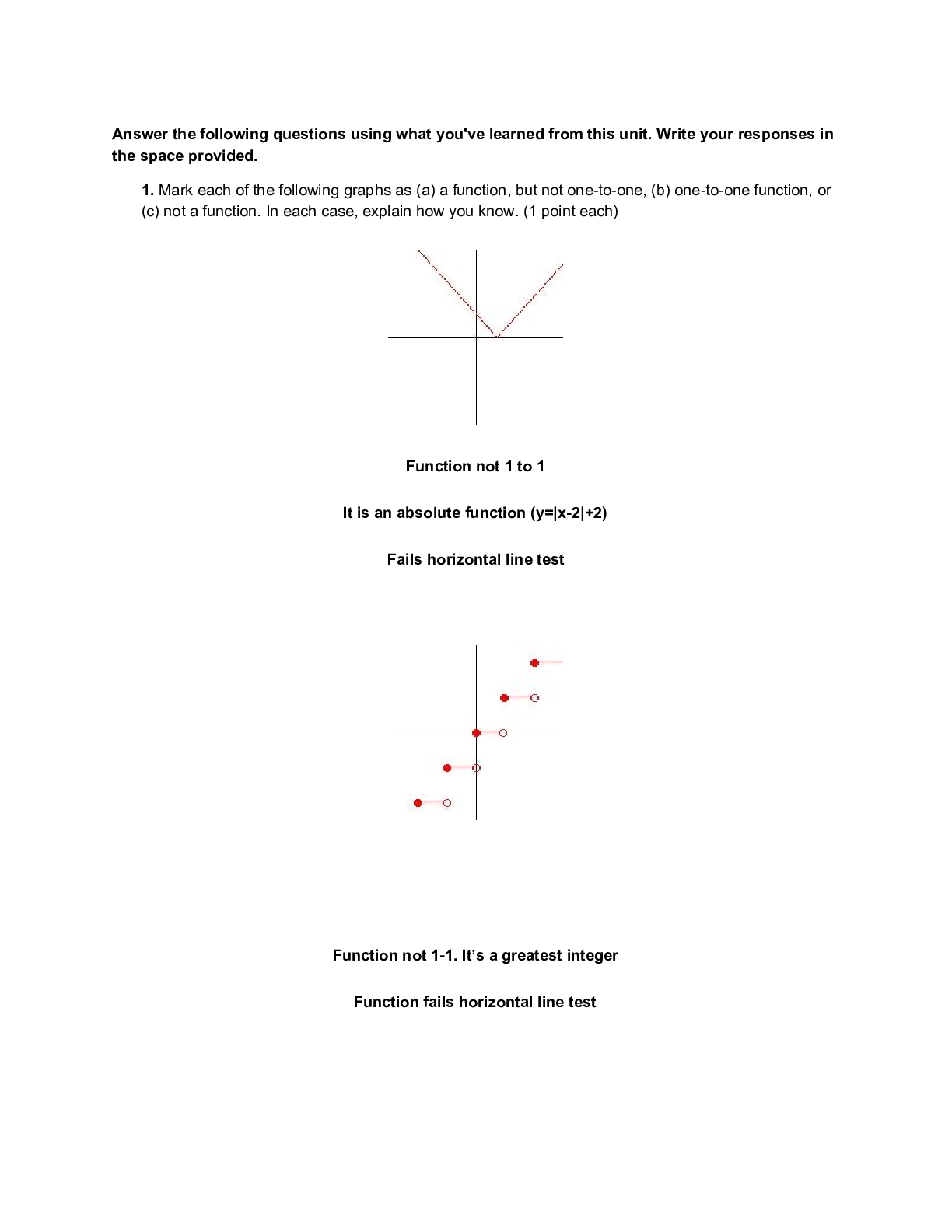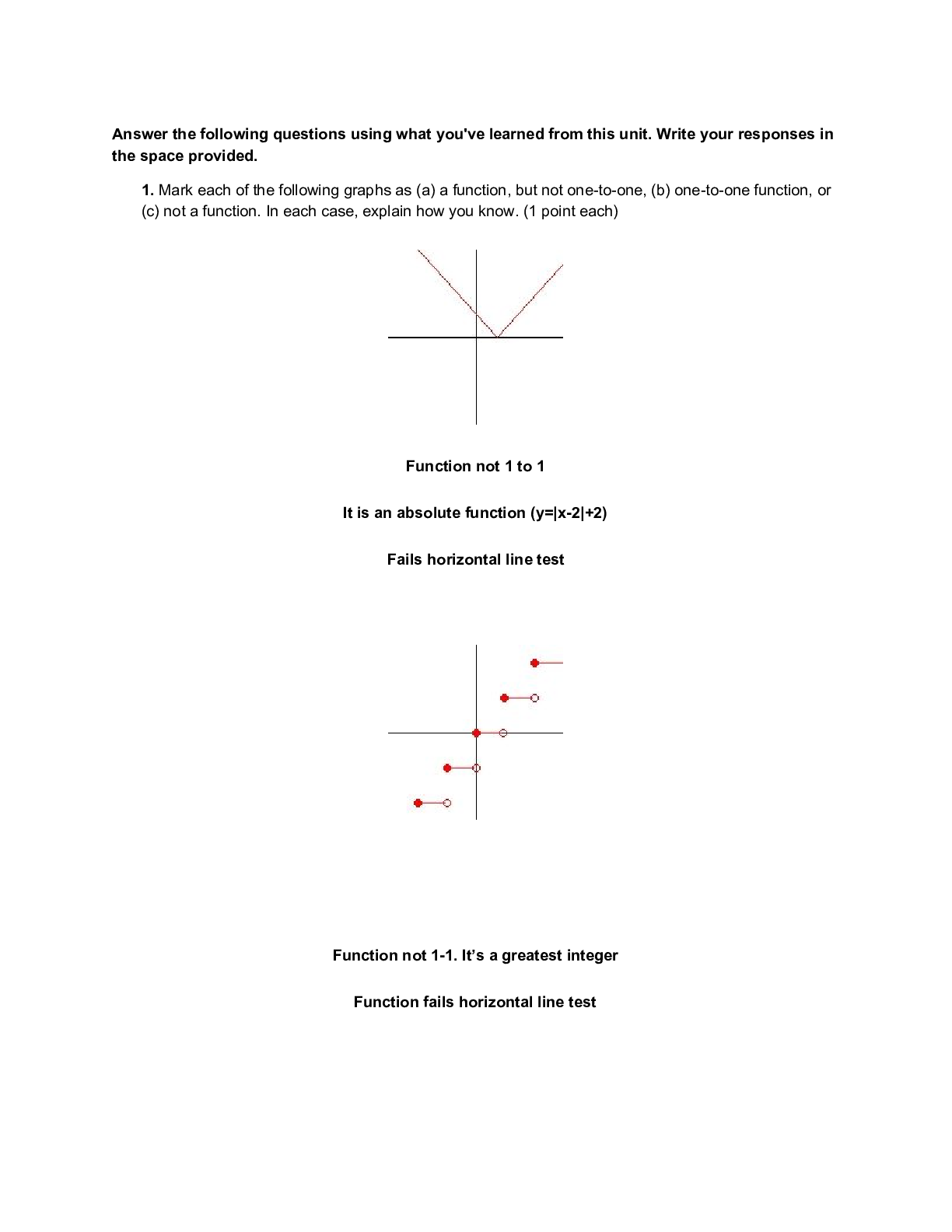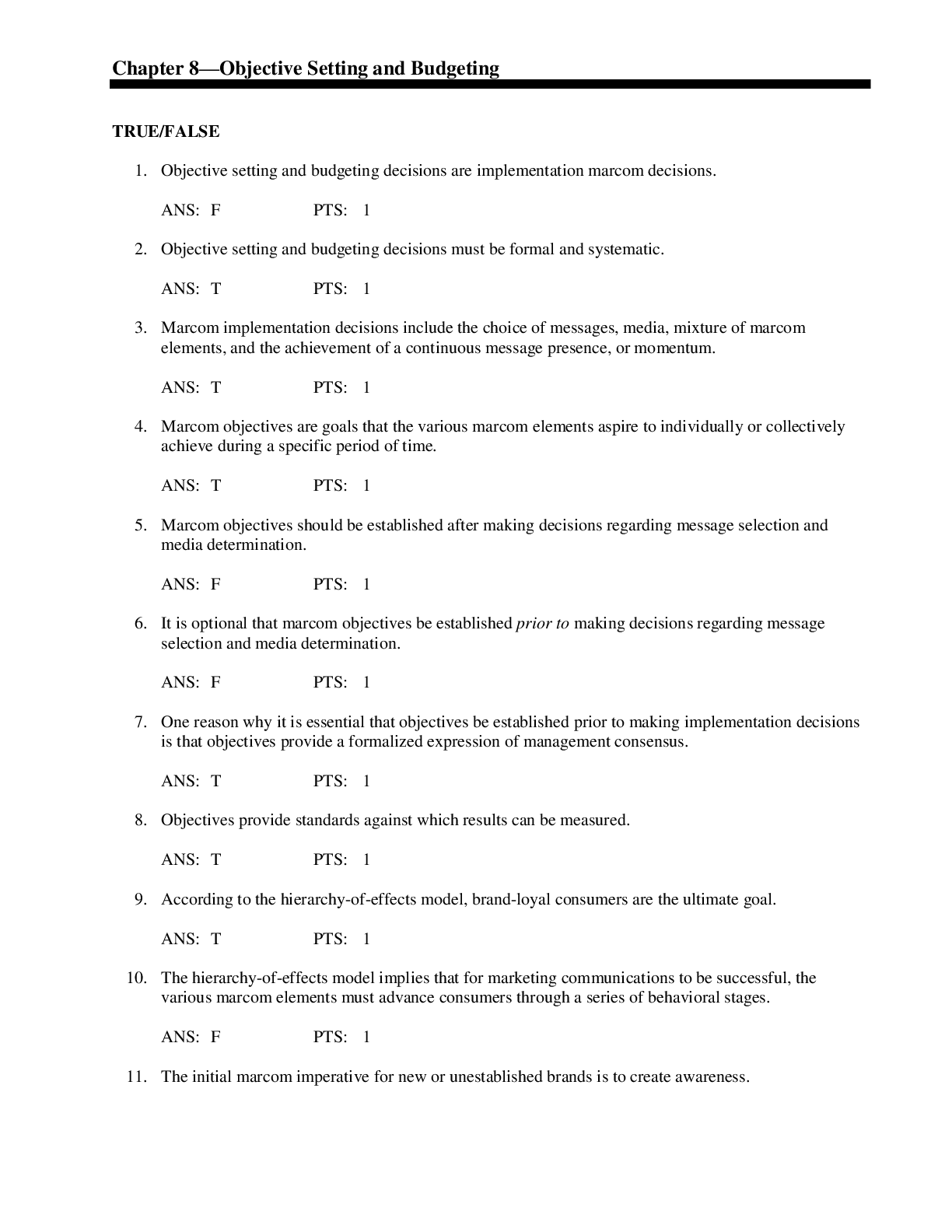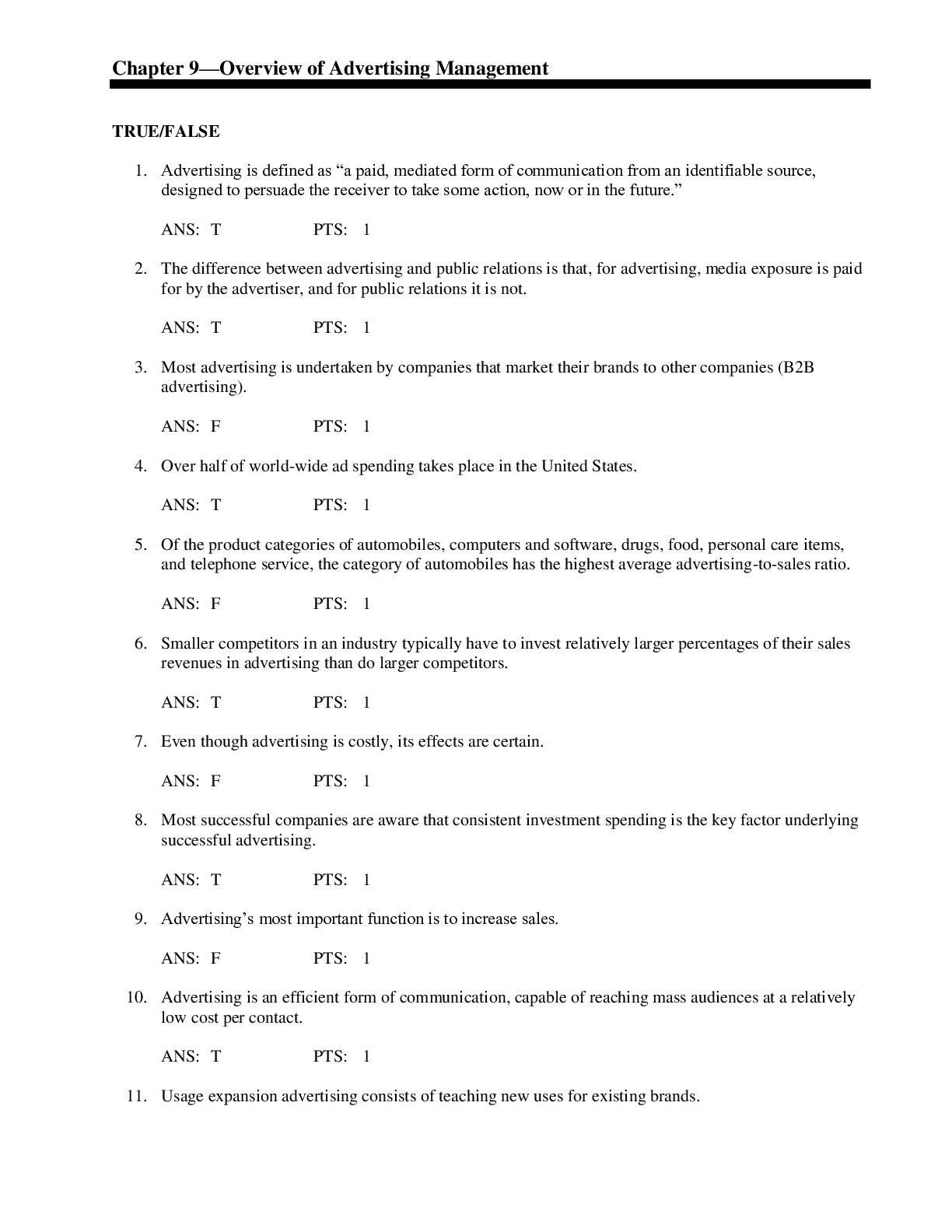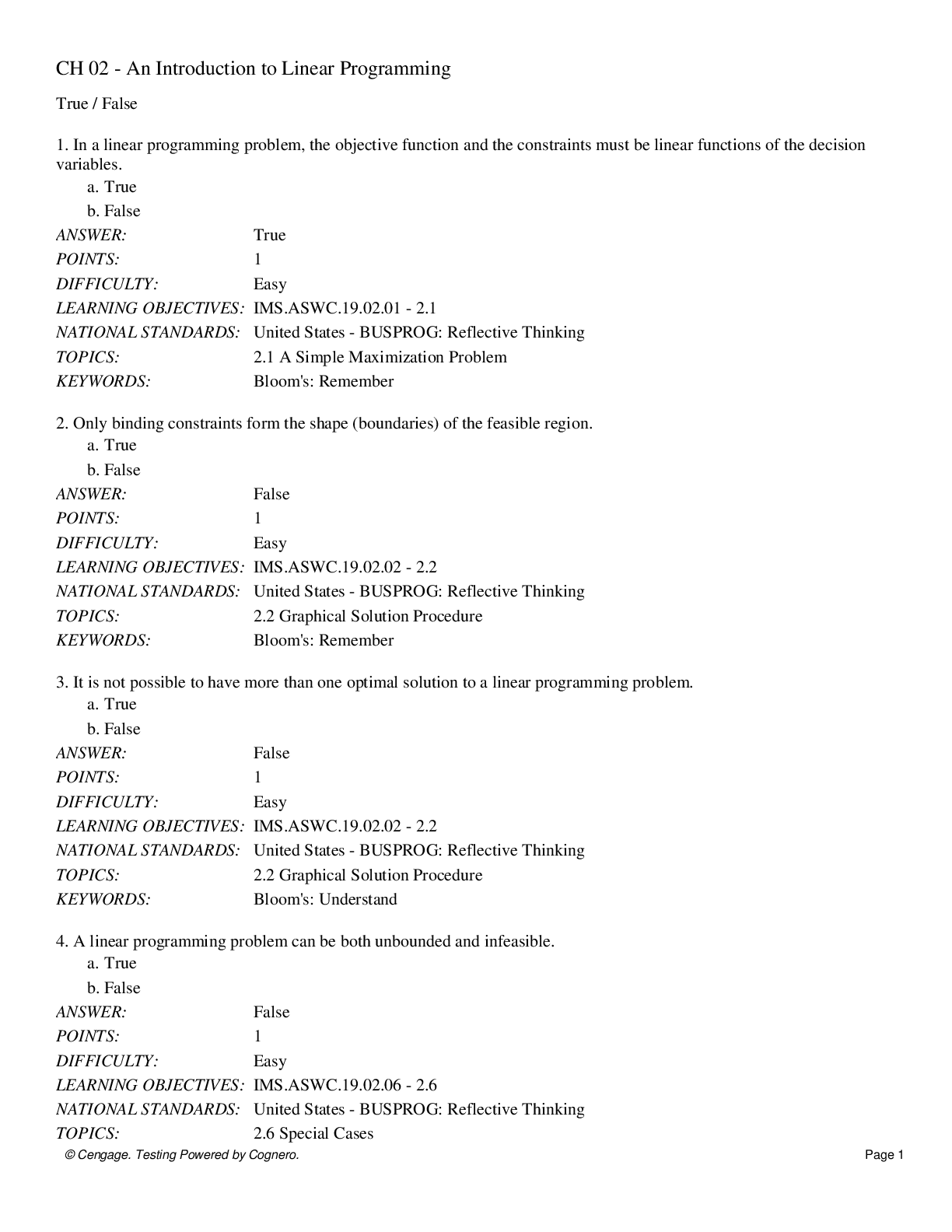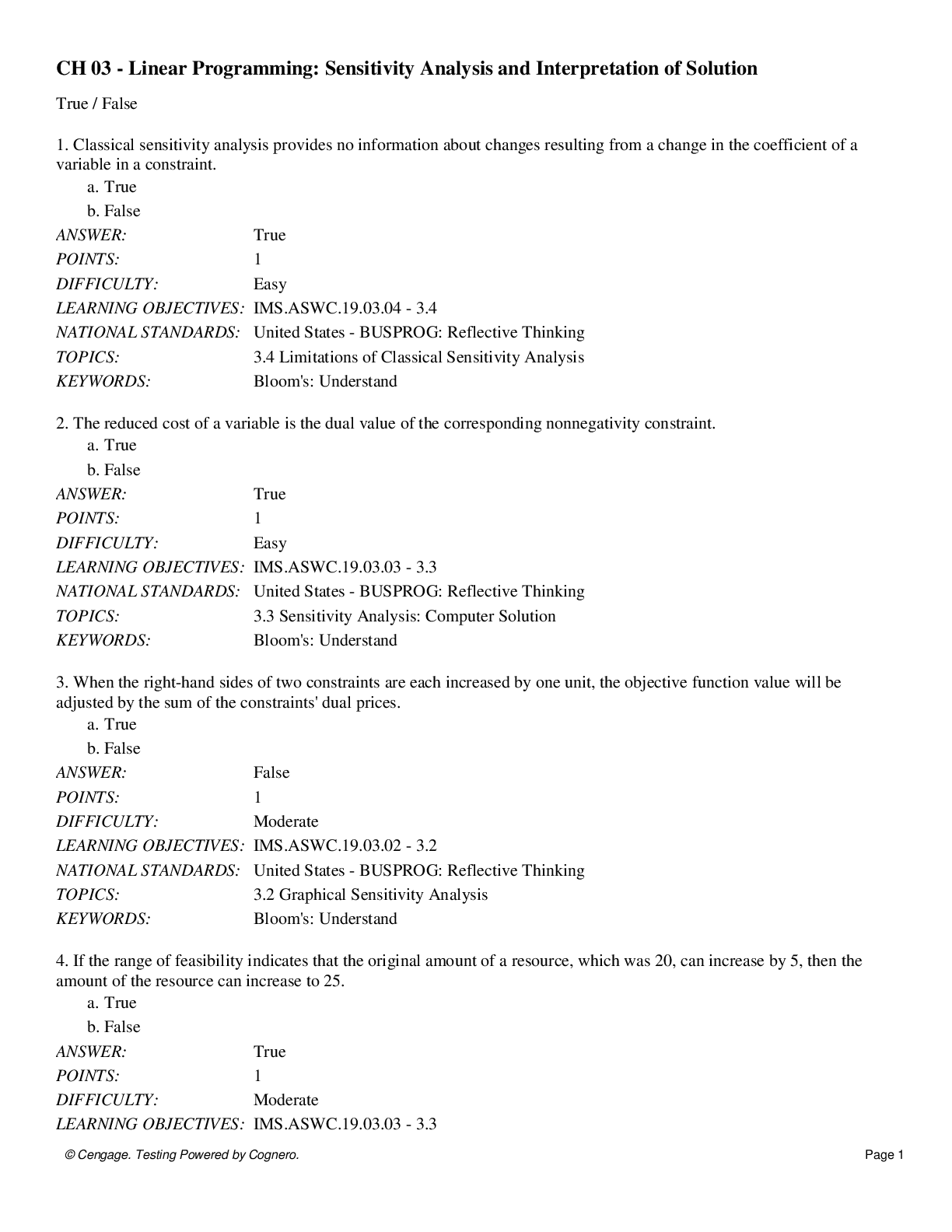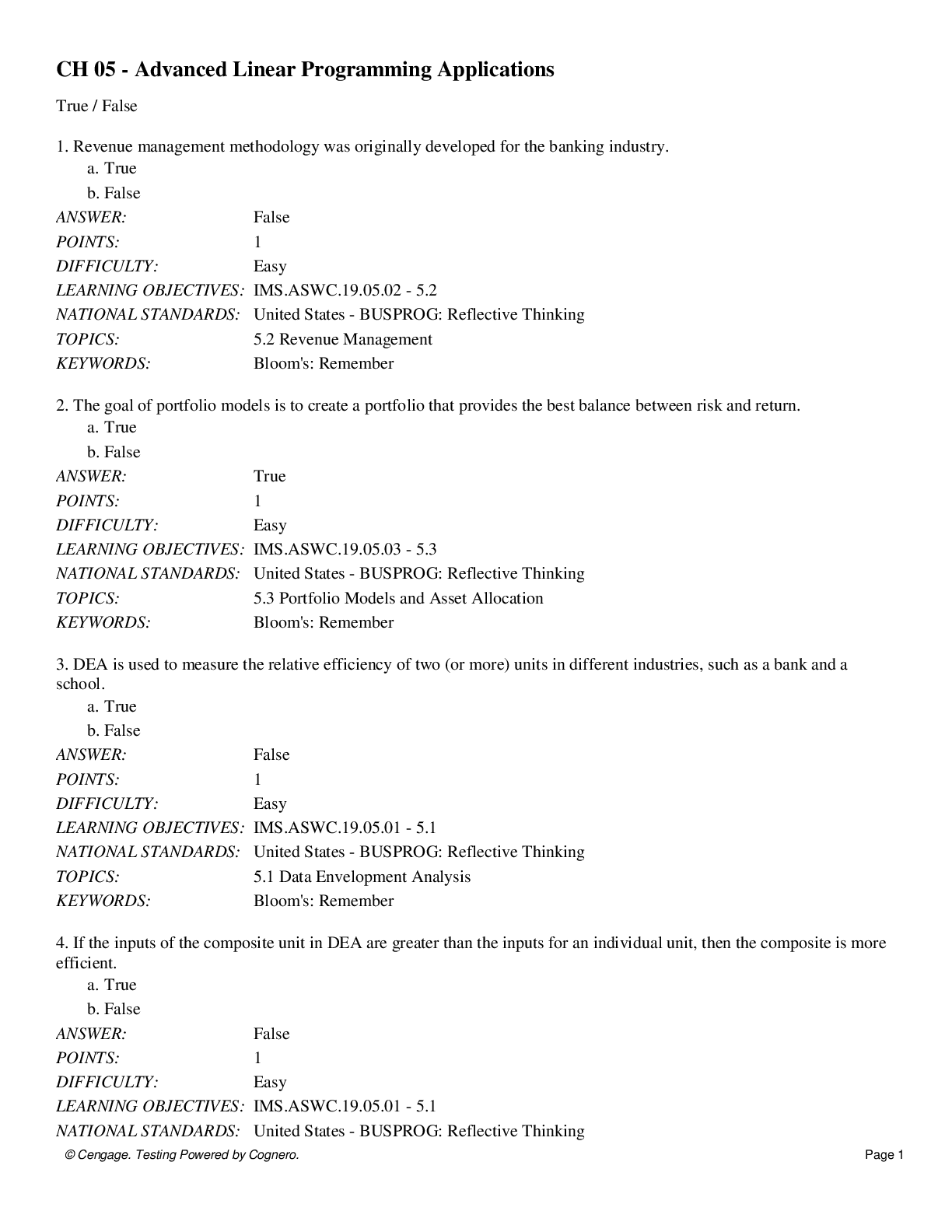*NURSING > QUESTIONS & ANSWERS > NURSING: SAFETY Questions and Answers with Explanation: Exam Practice and Review (All)
NURSING: SAFETY Questions and Answers with Explanation: Exam Practice and Review
Document Content and Description Below
NURSING: SAFETY Questions and Answers with Explanation: Exam Review Question 1 See full question A 15-year-old adolescent confides in the nurse that he has been contemplating suicide. He says he... has developed a specific plan to carry it out and pleads with the nurse not to tell anyone. What is the nurse's best response? Question 2 See full question As a client is being released from restraints, he says, "I'll never get that angry and lose it again. Those restraints were the worst things that ever happened to me." Which response by the nurse is most appropriate? Question 3 See full question Which instruction should a nurse include in an injury-prevention plan for a pregnant client? Question 4 See full question A client with stage II Alzheimer's disease is admitted to the short stay unit after cardiac catheterization that involved a femoral puncture. The client is reminded to keep his leg straight. A knee immobilizer is applied, but the client repeatedly attempts to remove it. The nurse is responsible for three other clients who underwent cardiac catheterization. What's the best step the nurse can take? Question 5 See full question A client diagnosed with schizophrenia for the last 2 years tells the nurse who has brought the morning medications, "That is not my pill! My pill is blue, not green." What should the nurse tell the client? Question 6 See full question The nurse is admitting a child who has been diagnosed with bacterial meningitis to the pediatric unit. The nurse should implement which type of isolation? Question 7 See full question The nurse is preparing a community education program about preventing hepatitis B infection. Which information should be incorporated into the teaching plan? Question 8 See full question A client with a suspected brain tumor is scheduled for a computed tomography (CT) scan. What should the nurse do when preparing the client for this test? Question 9 See full question While making rounds, the nurse enters a client’s room and finds the client on the floor between the bed and the bathroom. The nurse should first: Question 10 See full question A 13-year-old is having surgery to repair a fractured left femur. As a part of the preoperative safety checklist, what should the nurse do? Question 11 See full question When the client is involuntarily committed to a hospital because he is assessed as being dangerous to himself or others, which client rights are lost? Question 12 See full question A nurse is caring for a client following a tonsillectomy and fails to routinely assess the back of the client’s throat for signs of bleeding. The nurse manager reviews the client’s chart and notices the omission of the assessments. Which of the following is the best response to the nurse regarding the missing assessments? Question 13 See full question A nurse realizes that data has been entered on the wrong client's written health record. Which of the following steps should the nurse take to correct this documentation error? Question 14 See full question A school nurse is conducting a seminar for parents of preschool children on the prevention of head injuries. What is the most appropriate information for the nurse to give the parents? Question 15 See full question A nurse is providing injury-prevention education to the parents of a school-aged child. The parents admit that they keep a gun in their home. Which of the nurse's statements is most appropriate? Question 16 See full question A nurse is caring for a client with acquired immunodeficiency syndrome (AIDS). To adhere to standard precautions, the nurse should wear gloves when: Question 17 See full question A client is diagnosed with esophageal cancer and presents with difficulty swallowing. Which intervention should receive the highest priority? Question 18 See full question A healthcare provider has entered orders for a client with chronic obstructive pulmonary disease (COPD). Which of the following orders should the nurse question? Question 19 See full question A client who had a total hip placement at 0900 is receiving an autologous blood transfusion that was started at 1100. At the change of shift (1500), the nurse working on the day shift reports that there is 50 mL of the unit of blood remaining to be infused. Which is a priority action for the nurse working on the evening shift? Question 20 See full question While administering medication, the client tells the nurse, “I’ve never seen this pill before.” The nurse should: Question 1 See full question After an infant undergoes surgical repair of a cleft lip, the physician orders elbow restraints. For this infant, the postoperative care plan should include which nursing action? Question 2 See full question Which item in the care plan for a toddler with a seizure disorder should a nurse revise? hecking vital signs during a seizure. Question 3 See full question A nurse notices that a client admitted for treatment of major depression is pacing, agitated, and becoming verbally aggressive toward other clients. What is the immediate care priority? Question 4 See full question In the emergency department, a client with facial lacerations states that her husband beat her with a shoe. After her lacerations are repaired, the client waits to be seen by the crisis intake nurse, who will evaluate the continued threat of violence her husband represents. Suddenly the client's husband arrives, shouting that he wants to "finish the job." What is the first priority of the nurse who witnesses this scene? Question 5 See full question A client in early labor is connected to an external fetal monitor. The physician hasn't noted any restrictions on her chart. The client tells the nurse that she needs to go to the bathroom frequently and that her partner can help her. How should the nurse respond? Question 6 See full question An emergency department nurse is awaiting the arrival of multiple persons exposed to botulism at the local shopping mall. What should the nurse do? Question 7 See full question An older infant who has been injured in an automobile accident is to wear a splint on the injured leg. The mother reports that the infant has become mobile even while wearing the splint. What should the nurse advise the mother to do? Question 8 See full question A 3-year-old child receiving chemotherapy after surgery for a Wilms' tumor has developed neutropenia. The parent is trying to encourage the child to eat by bringing extra foods to the room. Which food would not be appropriate for this child? Question 9 See full question Question 10 See full question A client with suspected severe acute respiratory syndrome (SARS) comes to the emergency department. Which physician order should the nurse implement first? Question 11 See full question A 26-year-old is being treated for delirium due to acute alcohol intoxication. The client is restless, does not want to stay seated, and has a staggering gait. What should the nurse do first? Question 12 See full question The children of an elderly male client who has suffered an ischemic stroke have informed the nurse that an herbalist will be coming to their father’s bedside tomorrow to make recommendations for his care. Which of the following considerations should the nurse prioritize in light of the practitioner’s planned visit? Remediation: Question 13 See full question After the discharge of a client from a surgical unit, the housekeeper brings a blue pill to the nurse. The pill was found in the sheets when the linens were removed from the client’s bed. The nurse reviews the client’s medication administration record, which shows that the client received this medication at 0800. What would be the nurse’s priority action? Remediation: Question 14 See full question A nurse is caring for a client with a fresh postoperative wound following a femoral–popliteal revascularization procedure. The nurse fails to routinely assess the pedal pulses on the affected leg, and missed the warning sign that the blood vessel was becoming occluded. The nurse manager is made aware of the complication and the nurse’s failure to assess the client properly. What action should be taken by the nurse manager? Question 15 See full question A client is scheduled for a renal arteriogram. No allergies are recorded in the client's medical record, and the client is unable to provide allergy information. During the arteriogram, the nurse should be alert for which assessment finding that may indicate an allergic reaction to the dye used? Question 16 See full question Which instructions should a home care nurse provide for a client with acquired immunodeficiency syndrome (AIDS)? Question 17 See full question Which action by the nursing assistant would require immediate intervention by the nurse? Question 18 See full question A parent of a 9-year-old child who is scheduled to have surgery expresses concern about the potential for a postoperative infection. Which of the following information would be most important for the nurse to tell the parent? Question 19 See full question The nurse is conducting a routine risk assessment at a prenatal visit. Which question would be the best to screen for intimate partner violence? Question 20 See full question A client returns to the nursing division after a procedure. The client tells the nurse that the client was awake during the procedure and recalls certain events. What is the nurse’s priory intervention? Question 1 See full question After his spouse has visited, a client begins crying and saying that his spouse is a mean person. When the client starts pounding on the overbed table and using incomprehensible language, the nurse feels she can't handle the situation. What should the nurse do at this time? Question 2 See full question A child, age 3, who tests positive for the human immunodeficiency virus (HIV) is placed in foster care. The foster parents ask the nurse how to prevent HIV transmission to other family members. How should the nurse respond? Question 3 See full question A parent of a 9-year-old-child scheduled to have surgery expresses concern about the potential for postoperative infection. A nurse provides the parent with information about the measures taken to maintain surgical asepsis. Typical surgical asepsis involves: Question 4 See full question A nurse observes a nursing assistant bending over a bed as she helps an obese client sit up. The nurse discusses her observations with the nursing assistant to reinforce the need for proper body mechanics. Which response indicates that the nursing assistant understands these principles? Select all that apply. Question 5 See full question A client reports to a physician's office for intradermal allergy testing. Before testing, the nurse provides client teaching. Which client statement indicates a need for further education? Question 6 See full question To prepare the community for the possible threat of anthrax, a nurse must teach that: Question 7 See full question A nursing instructor is instructing group of new nursing students. The instructor reviews that surgical asepsis will be used for which of the following procedures? Question 8 See full question A parent tells the nurse that their 6-year-old child has severe nosebleeds. To manage the nosebleed, the nurse should tell the parent to: Question 9 See full question The nurse manager of a surgical unit observes a nurse providing colostomy care to a client without using any personal protective equipment (PPE). What is the most appropriate response by the nurse manager in relation to the use of PPE? Question 10 See full question A client has an indwelling urinary catheter and is prescribed physical therapy. As the client is being placed in a wheelchair, which action by the assistant would need further clarification by the nurse? Question 1 See full question A toddler with bacterial meningitis is admitted to the inpatient unit. Which infection control measure should the nurse be prepared to use? Question 2 See full question A nurse is teaching bicycle safety to a child and his parents. What protective device should the nurse tell the parents is most important in preventing or lessening the severity of injury related to bicycle crashes? Question 3 See full question The fire alarm sounds on the maternal-neonatal unit at 0200. How can a nurse best care for her clients during a fire alarm? Question 4 See full question An alarm signals, indicating that a neonate's security identification band requires attention. The nurse responds immediately and finds that the parents removed the identification bands from the neonate. Which action should the nurse take next? Question 5 See full question A client with chronic progressive multiple sclerosis is learning to use a walker. What instruction will best ensure the client's safety? Question 6 See full question A nurse has just been trained in how to use and care for a new blood glucose monitor. Which nursing intervention demonstrates proper use of a blood glucose monitor? Question 7 See full question The nurse is meeting weekly with an adolescent recently diagnosed with depression to monitor progress with therapy and antidepressant medication. The nurse should be most concerned when the client reports what information? Question 8 See full question In which situation can a client's confidentiality be breached legally? Question 9 See full question A nurse is teaching the parents of a preschooler about the possibility of post-operative hemorrhage after a tonsillectomy and adenoidectomy. When should the nurse explain that the risk of bleeding is the greatest? Question 10 See full question The nurse is preparing a community education program about preventing hepatitis B infection. Which information should be incorporated into the teaching plan? Question 11 See full question A client had a repair of a thoracoabdominal aneurysm 2 days ago. Which finding should the nurse consider unexpected and report to the health care provider (HCP) immediately? Question 12 See full question A nurse on a night shift entered an elderly client’s room during a scheduled check and discovered the client on the floor beside her bed after falling when trying to ambulate to the washroom. After assessing and assisting the client back to bed, the nurse has completed an incident report. What is the primary purpose of this particular type of documentation? Question 13 See full question Over the past few weeks, a client in a long-term care facility has become increasingly unsteady. The nurses are worried that the client will climb out of bed and fall. Which of the following measures does not comply with a least restraint policy? Question 14 See full question A nurse reports to the hospital occupational health nurse (OHN) that he/she was splashed with blood during the resuscitation of an HIV-positive client. The nurse asks the OHN when he/she will know whether he/she is positive or negative for HIV infection. Which of the following is the most appropriate response by the OHN? Question 15 See full question Which of the following is the priority action the nurse should take when finding medications at a client’s bedside? Question 16 See full question A client is scheduled for a renal arteriogram. No allergies are recorded in the client's medical record, and the client is unable to provide allergy information. During the arteriogram, the nurse should be alert for which assessment finding that may indicate an allergic reaction to the dye used? Question 17 See full question The nurse is caring for a client admitted for pneumonia with a history of hypertension and heart failure. The client has reported at least one fall in the last 3 months. The client may ambulate with assistance, has a saline lock in place, and has demonstrated appropriate use of the call light to request assistance. Using the Morse Fall Scale (see chart), what is this client’s total score and risk level? Question 18 See full question A nurse is caring for an infant who requires intravenous therapy. The nurse notes that the only available IV pump is in a toddler’s room. In which order should the nurse complete the following actions? 1. Remove pump from toddler's room 2. Clean the pump 3. Take pump into infant’s room 4. Use the pump Question 19 See full question The nurse assists the client to the operating room table and supervises the operating room technician preparing the sterile field. Which action, completed by the surgical technician, indicates to the nurse that a sterile field has been contaminated? Question 20 See full question A client is admitted to the emergency department with sneezing and coughing. The client is in the triage area, waiting to be seen by a health care provider (HCP). To prevent spread of infection to others in the area and to the health care staff, the nurse should: Question 1 See full question A nurse is performing a sterile dressing change. Which action contaminates the sterile field? Question 2 See full question A nurse is teaching parents how to reduce the spread of impetigo. The nurse should encourage parents to: Question 3 See full question A client is transferred from the emergency department to the locked psychiatric unit after attempting suicide by taking 200 acetaminophen tablets. The client is now awake and alert but refuses to speak with the nurse. In this situation, the nurse's first priority is to: Question 4 See full question X-rays reveal a leg fracture in a client who was brought to the emergency department after falling on ice. After a cast is applied and allowed to dry, the nurse teaches the client how to use crutches. Which instruction should the nurse provide about climbing stairs? Question 5 See full question Which activity should the nurse recommend to the client on an inpatient unit when thoughts of suicide occur? Question 6 See full question A 7-year-old child is admitted to the hospital with acute rheumatic fever with chorea-like movements. Which eating utensil should the nurse remove from the meal tray? Question 7 See full question A client has a coxackie B (viral) or trypanosomal (parasite) infection. The nurse should further assess the client for: Question 8 See full question An alert and oriented elderly client is admitted to the hospital for treatment of cellulitis of the left shoulder after an arthroscopy. Which fall prevention strategy is most appropriate for this client? Question 9 See full question A client in the postanesthesia care unit is being actively rewarmed with an external warming device. How often should the nurse monitor the client's body temperature? Question 10 See full question The nurse is removing the client's staples from an abdominal incision when the client sneezes and the incision splits open, exposing the intestines. What should the nurse do first? Question 11 See full question The charge nurse on a hematology/oncology unit is reviewing the policy for using abbreviations with the staff. The charge nurse should emphasize which information about why dangerous abbreviations need to be eliminated? Select all that apply. Question 12 See full question The nurse from the nursery is bringing a newborn to a mother’s room. The nurse took care of the mother yesterday and knows the mother and baby well. The nurse should implement which Question 13 See full question A client is to have a below-the-knee amputation. Prior to surgery, the circulating nurse in the operating room should: Question 14 See full question A client is admitted to the Emergency Department with a full thickness burn to the right arm. Upon assessment, the arm is edematous, fingers are mottled, and radial pulse is now absent. The client states that the pain is 8 on a scale of 1 to 10. The nurse should: Question 15 See full question The nurse is transferring an immobilized client. What is the best way for the nurse to maintain safety? Select all that apply. Question 16 See full question A nurse practitioner (NP) orders an antibiotic to which the client is allergic. The nurse preparing the medication notices the allergy alert and contacts the NP by phone. The NP does not return the call and the first dose is due to be given. Which of the following actions by the nurse is the best solution to this situation? Question 17 See full question A staff nurse is caring for a child with a urinary tract infection. The nurse is 1 hour late administering the child’s prescribed antibiotic therapy and pain medication. The charge nurse challenges the staff nurse about the lateness of the medications. The staff nurse responds, “It’s no big deal; at least the child got the medication.” What is the best course of action for the charge nurse to take? Question 18 See full question A healthcare provider has entered orders for a client with chronic obstructive pulmonary disease (COPD). Which of the following orders should the nurse question? Question 19 See full question Which question has been added to nursing admission assessment to screen for the Zika virus? Question 20 See full question A client returns to the nursing division after a procedure. The client tells the nurse that the client was awake during the procedure and recalls certain events. What is the nurse’s priory intervention? TAKE A PRACTICE QUIZ Question 2 See full question A client’s blood pressure is elevated at 160/90 mm Hg. The health care provider (HCP) prescribed “clonidine 1 mg by mouth now.” The nurse sent the prescription to pharmacy at 0710, but the medication still has not arrived at 0800. The nurse should do all except: Question 3 See full question A client is admitted to the psychiatric unit exhibiting extreme agitation, disorientation, and incoherence of speech with frantic and aimless physical activity and grandiose delusions. Which of the following would the highest priority goal in planning nursing interventions? Question 4 See full question A nurse-manager identifies fall prevention as a unit priority. Which of the following actions can the nurses implement to meet these goals? Select all that apply. Question 5 See full question A nurse is administering a newly prescribed IV antibiotic to a client who suddenly develops wheezing and dyspnea. Which of the following is the nurse’s priority action? Question 1 See full question What should a nurse do to ensure a safe hospital environment for a toddler? Question 2 See full question A nurse notices that a client admitted for treatment of major depression is pacing, agitated, and becoming verbally aggressive toward other clients. What is the immediate care priority? Question 3 See full question A nurse is preparing to perform a physical examination on a postpartum client. The client asks the nurse why gloves are necessary for the examination. What is the nurse's best response? Question 4 See full question A nurse preparing to discharge a child with leukemia observes a family member who has a cold sharing a meal with the child. How should the nurse approach the situation? Question 5 See full question A 31-year-old client, G3, T0, P2, Ab0, L0 at 32 weeks’ gestation, is being admitted to the hospital with contractions of moderate intensity occurring every 3 to 4 minutes per the client report. The client is crying on admission; the history reveals that the client has previously had two nonviable fetuses at 30 weeks’ gestation. What nursing action would be the highest priority for this client? Question 6 See full question A 29-year-old multigravida at 37 weeks' gestation is being treated for severe preeclampsia and has magnesium sulfate infusing at 3 g/h. To maintain safety for this client, the priority intervention is to: Question 7 See full question The nurse in the emergency department reports there is a possibility of having had direct contact with blood of a client who is suspected of having HIV/AIDS. The nurse requests that the client have a blood test. Consent for human immunodeficiency virus (HIV) testing can only be completed when which circumstances are present? Select all that apply. Question 8 See full question A client has soft wrist restraints to prevent the client from pulling out the nasogastric tube. Which nursing intervention should be implemented while the restraints are on the client? Question 9 See full question A client is 4 days postoperative from a tibia fracture and has a long leg cast. The nurse is conducting initial teaching for walking with crutches. What is the most important activity for the nurse to encourage the client to do prior to discharge from the hospital? Question 10 See full question The nurse is teaching the family of a client diagnosed with leukemia about ways to prevent infection. Which instruction has the most impact? Question 1 See full question The nurse-manager of a 20-bed coronary care unit is not on duty when a staff nurse makes a serious medication error that results in a client’s overdose. The client nearly dies. Which statement accurately reflects the accountability of the nurse-manager? Question 2 See full question A client has a coxackie B (viral) or trypanosomal (parasite) infection. The nurse should further assess the client for: Question 3 See full question The nurse manager is developing a "read-back" procedure to reduce medication administration errors. Which are purposes of the "read-back" requirement? Select all that apply. Question 4 See full question A client who was bitten by a wild animal is admitted to an acute care facility for treatment of rabies. Which type of isolation does this client require? Question 5 See full question A multigravid client is admitted at 4-cm dilation and is requesting pain medication. The nurse gives the client nalbuphine 15 mg. Within five minutes, the client tells the nurse she feels like she needs to have a bowel movement. The nurse should first: Question 6 See full question A nurse on a night shift entered an elderly client’s room during a scheduled check and discovered the client on the floor beside her bed after falling when trying to ambulate to the washroom. After assessing and assisting the client back to bed, the nurse has completed an incident report. What is the primary purpose of this particular type of documentation? Question 7 See full question A nurse in a psychiatric care unit finds that a client with psychosis has become violent and has struck another client in the unit. What action should the nurse take in this case? Question 8 See full question A 10-month-old infant is admitted with a harsh, barking cough and respiratory stridor. What are the most appropriate precautions for the nurse to follow when caring for the child? Question 9 See full question A client is scheduled for a renal arteriogram. No allergies are recorded in the client's medical record, and the client is unable to provide allergy information. During the arteriogram, the nurse should be alert for which assessment finding that may indicate an allergic reaction to the dye used? Question 10 See full question The nurse is assessing the client (see photo) who has recently returned from a 2-month mission in Africa. What type of respiratory protection is appropriate for the staff? Question 1 See full question A mother of a 5-year-old child who was admitted to the hospital has a Protection from Abuse order for the child against his father. A copy of the order is kept on the pediatric medical surgical unit where the child is being treated. The order prohibits the father from having any contact with the child. One night, the father approaches the nurse at the nurses' station, politely but insistently demanding to see his child, and refusing to leave until he does so. What should the nurse do first? Question 2 See full question A client is admitted to the acute psychiatric care unit after 2 weeks of increasingly erratic behavior. He has been sleeping poorly, has lost 8 lb (3.6 kg), is poorly groomed, exhibits hyperactivity, and loudly denies the need for hospitalization. Which nursing intervention takes priority for this client? Question 3 See full question A diagnosis of hemophilia A is confirmed in an infant. Which of the instructions should the nurse provide the parents as the infant becomes more mobile and starts to crawl? Question 4 See full question A nurse notes that another nurse on the previous shift made an entry on the wrong client’s health record. What are the most appropriate steps for the first nurse to take? TQuestion 1 See full question A nurse realizes she is 1 hour late in administering a dose of medication for a 4-year-old child. She gives the medication immediately, and assesses the child. The child isn't harmed by the delay. Which action should the nurse take next? Question 1 See full question A mother of a 5-year-old child who was admitted to the hospital has a Protection from Abuse order for the child against his father. A copy of the order is kept on the pediatric medical surgical unit where the child is being treated. The order prohibits the father from having any contact with the child. One night, the father approaches the nurse at the nurses' station, politely but insistently demanding to see his child, and refusing to leave until he does so. What should the nurse do first? Question 2 See full question Mental health laws in each state specify when restraints may be used and which type of restraints may be used. Most laws stipulate that restraints may be used: Question 3 See full question A nurse is walking down the hall in the main corridor of a hospital when the infant security alert system sounds and a code for an infant abduction is announced. The first responsibility of the nurse when this situation occurs is to take which action? Question 4 See full question A nurse is caring for a client with watery diarrhea and dehydration. Given the client's recent history of heavy antibiotic use, what interventions should the nurse consider? Question 5 See full question A nurse is caring for a client who is undergoing chemotherapy. Current laboratory values are noted on the medical record. Which action would be most appropriate for the nurse to implement? [Show More]
Last updated: 1 year ago
Preview 1 out of 57 pages
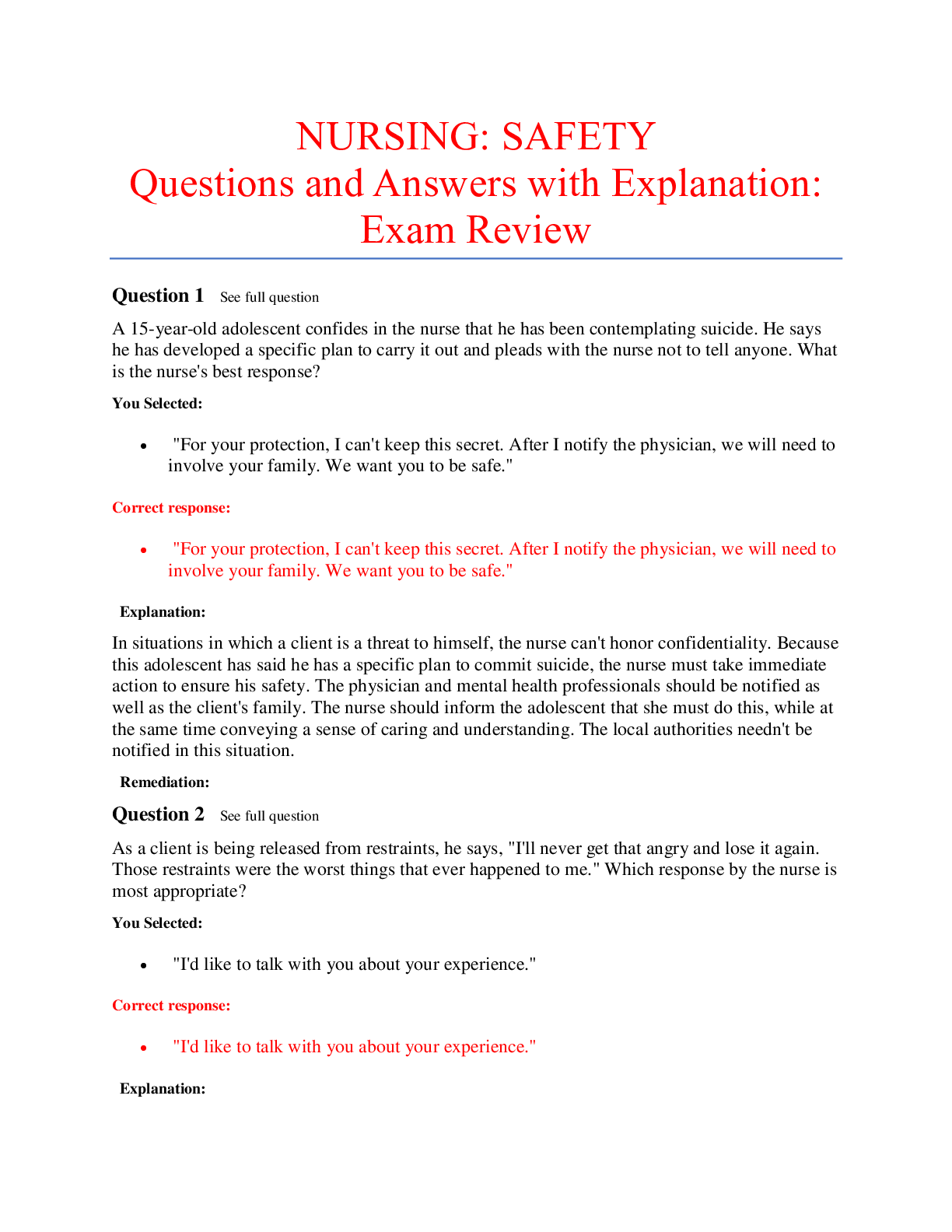
Buy this document to get the full access instantly
Instant Download Access after purchase
Add to cartInstant download
We Accept:

Reviews( 0 )
$9.50
Document information
Connected school, study & course
About the document
Uploaded On
Aug 02, 2020
Number of pages
57
Written in
Additional information
This document has been written for:
Uploaded
Aug 02, 2020
Downloads
0
Views
71

